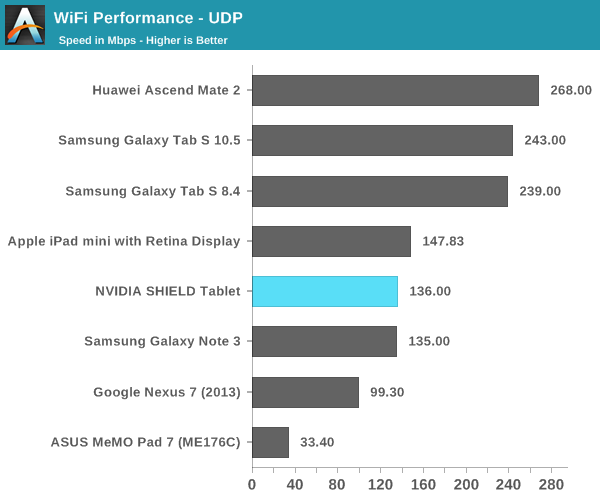The NVIDIA SHIELD Tablet Review
by Joshua Ho on July 29, 2014 9:00 AM ESTWiFi Performance
For the most part these days it seems that the situation for WiFi is much better in mobile than it is anywhere else, but it's still important to test throughput, especially on a device like the Shield tablet that requires low latency, high bandwidth connections in order to support GameStream and GRID. To this end, while NVIDIA hasn't shipped 802.11ac the Shield tablet ships with a 2x2 antenna configuration for a maximum PHY rate of 300 Mbps. Like the Shield portable, this is a BCM43241 chip, likely shared to improve economies of scale. To look at how it performs, we turn to iperf. Before we get into the results of the test, I'd like to thank ASUS for providing the RT-AC68U router to test WiFi perfomance.

Surprisingly, the Shield tablet performs about as well as some single stream 802.11ac solutions like the one found in the Galaxy Note 3. Performance is generally in line with what we'd expect for such a solution, although it would be nice to see 802.11ac for future products.
Camera
While I currently don't have the means to properly test camera, there are still some things to talk about for camera. Both the front and rear camera modules use OmniVision's OVT5963 sensor, which appears to be a 1/4", 5MP sensor. The rear camera has an F/2.0 aperture with 2.95mm focal length, and the front camera has an F/2.8 aperture, with a claimed 4.76mm focal length, although the field of view appears to be somewhat wider. This is the same sensor as the camera in the Nexus 7 (2013). As a rear facing camera, the quality is nothing special but as a front facing camera it's surprisingly high quality. The photo above is with the rear facing camera, the photo below is from the front facing camera. The stock camera application also doesn't show the correct aspect ratio for the camera, so the preview is cropped.
Audio
While I don't have the equipment available to test audio quality and peak volume quite yet, subjectively the two bass reflex ports and dual front facing speakers make for a great experience. It's definitely a major advantage over other devices when it comes to watching movies and playing games as I don't have to cup my hand around the speaker. The larger size of the tablet formfactor means that the stereo separation is much more obvious. On the headphone jack, the device appears to be using a Realtek RT5639 codec. It seems that NVIDIA has continued to use their own speaker protection system that runs on the SoC, as there isn't any clear evidence of a speaker protection IC connected via I2C.












174 Comments
View All Comments
fivefeet8 - Tuesday, July 29, 2014 - link
Maybe if Nvidia made a gamepad that was attachable to the Tablet and with good weight distribution. But then the Tablet is much larger though.tipoo - Tuesday, July 29, 2014 - link
I'm very curious to see the K1 version with two Denver CPU cores instead of four Cortex A15s.MonkeyPaw - Tuesday, July 29, 2014 - link
"There are still frame drops involved in scrolling through lists and similar areas where Android has traditionally struggled to stay smooth, but Android L should fix this issue for the most part."I chuckled when I read this. How many versions of Android have promised smooth UI frame rates? Since 4.1?
MS could get Tegra3 to smooth-scroll Windows!
CharonPDX - Tuesday, July 29, 2014 - link
Wow. When your "final words" section begins with "If I’m honest, it’s hard for me to review tablets... ... I’ve never really found a use for them." then I have to ask, why are you reviewing it?Shouldn't someone else at Anand be doing this review?
DarkStryke - Tuesday, July 29, 2014 - link
You hit it around here. Many of the non-Anand reviews the last while have been pretty average at best.bigstrudel - Tuesday, July 29, 2014 - link
Qualcomm has met its match here. That's what they get for leaning on Krait so long.fivefeet8 - Tuesday, July 29, 2014 - link
Qualcomm makes good SOC's but unfortunately their drivers suck in comparison. Hopefully they've increased investment on that part with their new Adreno 420.kgh00007 - Tuesday, July 29, 2014 - link
It's a pity that the review wasn't done by somebody who actually likes tablets or uses one daily to give a more subjective opinion, based on the fact that they actually use a tablet.For me I use one every day, mainly for reading articles like this on the web, the nexus 7 2013 is a perfect device for that sort of useage.
It's also a pity that the screen does not match up to the nexus 7 2013, I don't want to buy a tablet with a lesser screen regardless of specs!
Thanks for the review though!
name99 - Tuesday, July 29, 2014 - link
Why do you need a camera for "Twitch streaming"? Isn't the whole point of twitch streaming that you see what's happening on the TABLET?Is there something I'm missing here?
fivefeet8 - Tuesday, July 29, 2014 - link
It does both at the same time. It records what's on the Tablet and has a Pic-n-Pic of the camera video.